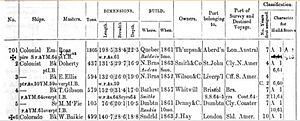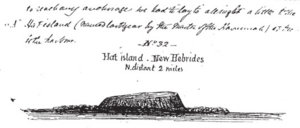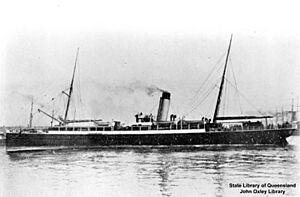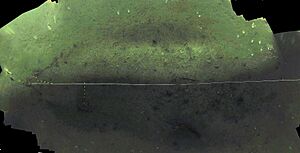Colonist (1861) facts for kids
class="infobox " style="float: right; clear: right; width: 315px; border-spacing: 2px; text-align: left; font-size: 90%;"
| colspan="2" style="text-align: center; font-size: 90%; line-height: 1.5em;" | 
|- | Ship registration number: | 57/1863 later 6/1871 |- | Ship official number: | 43699 |-
|- | Ship primary use: | |- | Ship industry: |- | Ship passenger capacity: | |-
|} The Colonist was a sailing ship called a schooner. It was built in 1861 in Dumbarton, Scotland. For almost 30 years, the Colonist sailed around the Western Pacific Ocean. Its home port was Sydney, Australia.
This ship had an exciting life! It was involved in gold rushes and even wrecked on a faraway reef. Sadly, its captain was murdered. Finally, the Colonist sank after a collision in Sydney Harbour.
Contents
- First Trip to the Pacific
- Early Years in Australia (1862–1864)
- Exploring the Western Pacific (1864–1865)
- Gold Rush Trips (1865–1866)
- Wrecked on Elizabeth Reef (1870)
| History | |
|---|---|
| Name | Colonist |
| Owner | John Phillips |
| Port of registry | |
| Builder | Denny & Rankine, Dumbarton, Scotland |
| Yard number | 140 |
| Launched | 1861 |
| Fate | Wrecked |
| General characteristics | |
| Type | Mainly described as a schooner but also a smack and a brigantine |
| Tonnage | 105 GRT |
| Length | 76 feet 6 inches (23.32 m) post 1871 78 feet 6 inches (23.93 m) |
| Beam | 20 feet 1 inch (6.12 m) |
| Height | 10 feet 5 inches (3.18 m) |
About the Colonist Ship
The Colonist was made of wood. It had strong iron bolts holding it together. The outside of the ship was covered with felt and a special metal called Muntz metal.
Here are some of its measurements:
- Length: about 23.3 meters (76 feet, 6 inches)
- Width: about 6.1 meters (20 feet, 1 inch)
- Depth: about 3.1 meters (10 feet, 5 inches)
The ship was usually set up as a schooner. This means it had two or more masts with sails that ran front-to-back. Sometimes, people also called it a brigantine, which is a similar type of sailing ship. It was built by Denny & Rankine in 1861.
The Colonist's Journeys
First Trip to the Pacific
The Colonist arrived in Dunedin, New Zealand, in April 1862. This was after a four-month journey from Scotland. Even though it was a small schooner, it handled the ocean very well. It was only 105 tons but proved to be a great little vessel.
During the trip, it was calm for about two weeks in the tropics. It also faced a very strong storm near Kerguelen Islands. The ship took on a lot of water but was not damaged. People said it was a "very superior vessel."
After this journey, the Colonist sailed to Newcastle, New South Wales. There, it was sold to an Australian company in Sydney. They wanted to use it for trading along the coast. The ship was known for being "remarkably fast." It could carry about 200 tons of goods.
Early Years in Australia (1862–1864)
In its first few years in Australia, the Colonist mostly sailed between Sydney, Brisbane, and Rockhampton. It was famous for making the trip from Sydney to Rockhampton very quickly. It took only six days from one dock to the other.
Captain Charles Croft was the ship's master during this time. He later left the Colonist to command another ship called the Faraway.
Exploring the Western Pacific (1864–1865)
Later, under Captain Joseph H. Scaplehorn, the Colonist began to travel further. It visited places like Guam, Batavia (which is now Jakarta, Indonesia), and Foo Chow (now Fuzhou, China).
At that time, Guam was controlled by Spain. Batavia was the main city for the Dutch in Indonesia. Fuzhou was a special port in China. It had been opened for British trade after a war.
The Colonist made a very fast trip from Foo Chow to Sydney. It took only 65 days! This showed again how quickly the ship could sail.
Gold Rush Trips (1865–1866)
The Colonist continued its journeys to Fuzhou and even to Petropavlovsk-Kamchatsky in Russia. During one trip, the ship ran into a big storm. The strong winds broke some of its ropes and gear. The ship started to leak, and the crew had to work hard to keep it safe.
The ship also made several trips to Hokitika, New Zealand. It carried gold prospectors and supplies for the West Coast Gold Rush. Many people were hoping to find gold there.
Wrecked on Elizabeth Reef (1870)
In 1870, the Colonist was sailing regularly between Sydney and New Caledonia. On May 18, it left Sydney with a full load of goods. A few days later, it hit Elizabeth Reef. This reef is a long way from New South Wales.
The ship struck the reef during a storm. The crew tried to keep the sails up to push the ship further onto the reef. This would stop it from being tossed around by the waves. A big wave broke the main sail. Another wave damaged the ship's small boat.
The crew managed to fix the boat a little. They left the ship and got into the calm water inside the reef. They built a raft and stayed there when it was too dangerous to be on the ship. Some of the crew decided to try and reach the mainland in the boat to get help.
On June 21, another schooner, the Joan Andrews, found the crew in their lifeboat. They were brought safely back to Sydney. A government ship, Thetis, then went to the reef to rescue the remaining crew. Six crew members had been on the wreck for 40 days!
Saving the Colonist
People started working to save the Colonist almost right away. Other ships were sent to the reef to rescue the cargo. Captain Paget stayed on the reef with some workers. They slowly managed to get the ship off the reef.
The Colonist finally returned to Sydney Harbour on March 2, 1871. This was more than eight months after it hit the reef! Everyone was surprised that the ship was not badly damaged. It was still strong and could be repaired.
New Guinea Gold Rush (1878)
Gold was found in Papua New Guinea in 1852. In early 1878, a missionary found more gold near Port Moresby.
In March 1878, the Colonist took the first big group of gold prospectors to Port Moresby. About 25 prospectors traveled from Sydney. More joined in Cooktown, Queensland. They were ready to search for gold for six months. They brought supplies, guns for protection, and tools for prospecting. They also brought items like tobacco and beads to trade with the local people. They wanted to treat the natives fairly.
When the Colonist arrived in Port Moresby, it carried important papers. These papers appointed William Bairstow Ingham as an agent for the Queensland Government. Ingham was one of the few Europeans living in Port Moresby at that time. Sadly, Ingham and six others were later killed on an island in November 1878.
By August, the Colonist had left the prospectors and returned to Sydney.
A Sad Event in 1889
On May 22, 1889, a tragic event happened on the Colonist. The ship was anchored in Port Havannah in Vanuatu. The ship's master, Captain William Greenlees, was shot and killed. This happened during a disagreement with another crew member, Henry Ernest Weaver.
Captain Greenlees had been sailing ships along the Australian coast for many years. He had commanded various vessels, including the Colonist for some time. After his death, his family received help from a shipwreck relief society.
Henry Ernest Weaver, who was also a captain, was later found responsible for the death. He was sentenced for his actions. Years later, he returned to Australia and tried to organize a new adventure to find treasure and minerals in the Solomon Islands. However, his investors lost trust in him, and the trip did not go as planned.
Collision and Sinking (1890)
The Colonist's final journey began on March 1, 1890. It left Kiama, New South Wales, carrying a load of blue metal (a type of crushed rock). It entered Sydney Harbour that afternoon.
As the Colonist was sailing towards Garden Island, New South Wales, a large steamship called the Adelaide appeared. The two ships collided! The Adelaide hit the Colonist on its right side. The schooner sank almost immediately.
Two crew members climbed onto the Adelaide using its anchor chains. Two other crew members and Captain Wilson were rescued from the water. Sadly, the mate, Frederick Taylor, was lost. His body was found several days later.
A small boat called the Young Oscar helped rescue the survivors. They picked up the captain, who was very tired in a life ring. They also rescued another man who was unconscious but later woke up.
An investigation found that the Colonist's captain was partly at fault for turning his ship in front of the steamer. He was given a warning to be more careful.
The Wreck Site
The Colonist sank in the shipping channel. To clear the way for other ships, the Marine Board ordered its removal. On April 23, the ship was blown up using dynamite.
Three charges of dynamite were used. A lot of wreckage flew into the air, including the ship's main mast. Many stunned fish floated to the surface. Divers later went down to clear more of the wreck. The hull of the Colonist sank deep into the mud.
The wreck lies about 20 meters (65 feet) underwater. It was found on May 13, 2013. Today, you can still see the outline of the metal that covered the hull. There is also a pile of blue metal, which was its last cargo.
Summary of Voyages
| Year | Month | Master of vessel | Route | Year | Month | Master of vessel | Route |
|---|---|---|---|---|---|---|---|
| 1861 | Dec-April 62 | Matthew McFie | Glasgow-Dunedin | 1870 | January | Alfred Douglas Millar Geach | New Caledonia - Sydney |
| 1862 | July | Otago NZ - Newcastle NSW | March | Alfred Douglas Millar Geach | New Caledonia - Sydney | ||
| July | Sale of vessel | Sale of vessel | Shipwreck on Elizabeth Reef | Shipwreck on Elizabeth Reef | |||
| Aug | Charles Croft | Newcastle - Melbourne | 1871 | March | Charles Paget | Elizabeth Reef - Sydney | |
| Aug | Charles Croft | Melbourne - Sydney - Rockhampton | 1872 | ||||
| December | Charles Croft | Rockhampton - Sydney | 1873 | October | William Greenlees | Rockhampton - Sydney | |
| 1863 | January | Joseph H. Scaplehorn | Rockhampton - Sydney | 1874 | July | John McAvery | Maryborough - Sydney |
| May | Joseph H. Scaplehorn | Sydney - Rockhampton | 1875 | January | John McAvery | Nauganui - Sydney | |
| August | Joseph H. Scaplehorn | Rockhampton - Sydney | 1876 | ||||
| 1864 | February | Joseph H. Scaplehorn | Sydney - Guam | 1877 | |||
| June | Joseph H. Scaplehorn | Batavia - Sydney | 1878 | March | Sydney - Port Morsby | ||
| December | Joseph H. Scaplehorn | Foo Chow - Sydney | August | J.A. Borstel | Port Douglas - Sydney | ||
| 1865 | January | Possible sale of vessel | Possible sale of vessel | 1879 | September | Tonga - Auckland | |
| January | William Pearce | Sydney - Petropavlovsk | 1880 | ||||
| October | William Pearce | Foo Chow Foo - Sydney | 1881 | ||||
| November | William Pearce | Hokitika - Sydney | 1882 | ||||
| November | Possible sale of vessel | Possible sale of vessel | 1883 | March | William Simpson | Caroline Island - Sydney | |
| December | George Francis Mason | Sydney - Hokitika | 1885 | ||||
| 1866 | January | George Francis Mason | Hokitika - Sydney | 1886 | |||
| March | George Kelly (Mate previous trip) | Hokitika - Sydney | 1887 | ||||
| May | George Kelly | Hokitika - Sydney | 1888 | ||||
| June | George Kelly | Petropavlovsk - Sydney | 1889 | August | E. Williams | Havannah Harbour | |
| 1867 | September | Alfred Douglas Millar Geach | New Caledonia - Sydney | ||||
| 1868 | Alfred Douglas Millar Geach murder | ||||||
| 1869 | February | Alfred Douglas Millar Geach | Maryborough - Sydney | 1890 | Collision and sinking | ||
| April | Alfred Douglas Millar Geach | New Caledonia - Sydney | |||||
| June | Alfred Douglas Millar Geach | New Caledonia - Sydney | |||||
| August | Alfred Douglas Millar Geach | New Caledonia - Sydney | |||||
| November | Alfred Douglas Millar Geach | New Caledonia - Sydney | |||||
| December | Alfred Douglas Millar Geach | New Caledonia - Sydney |








